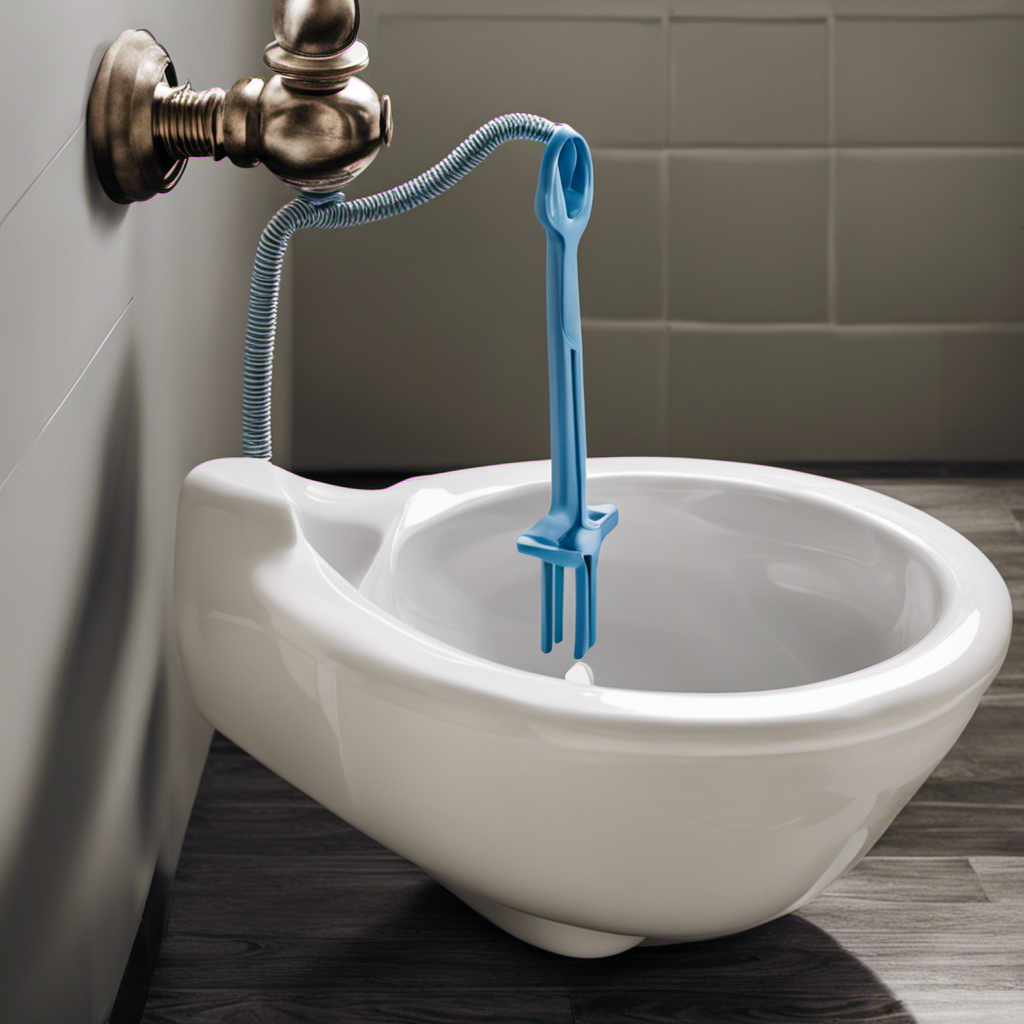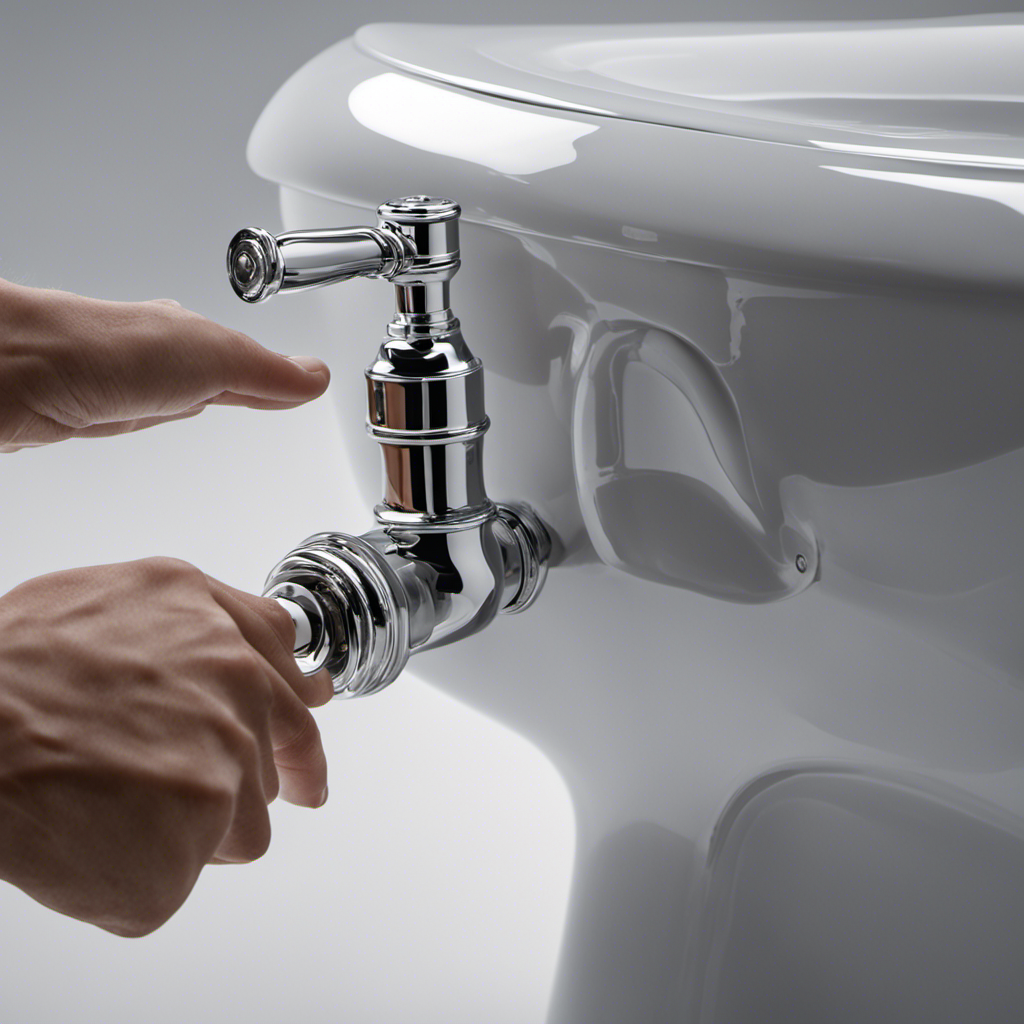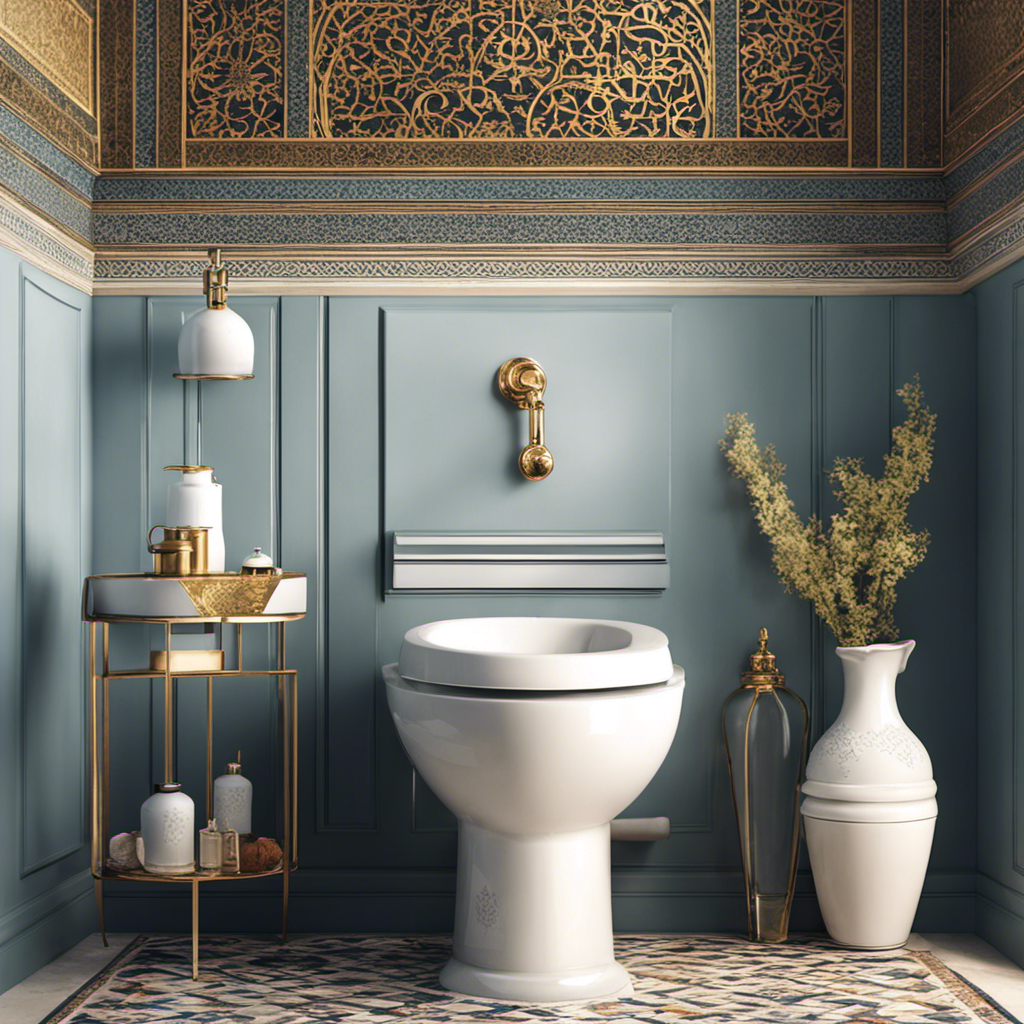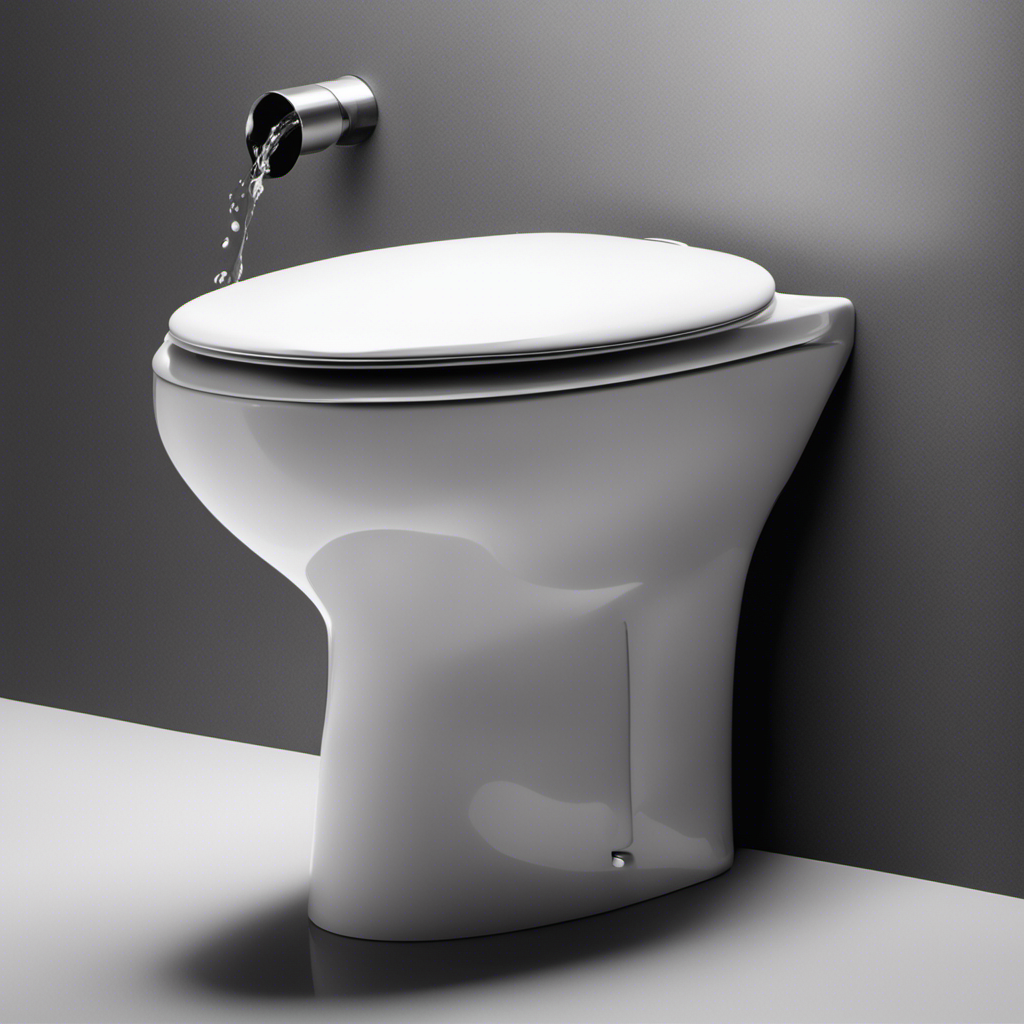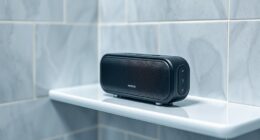Did you know that a badly blocked toilet can cause a major inconvenience and disrupt your daily routine? If you find yourself without a plunger, don’t panic!
In this article, I will guide you through the steps to unblock a toilet using alternative methods and homemade solutions. With the right tools and a little know-how, you can quickly and effectively clear the blockage without the need for a professional plumber.
So let’s get started and restore your toilet to its fully functional state.
Key Takeaways
- Excessive toilet paper usage and flushing items not designed to be flushed are common causes of a badly blocked toilet.
- Signs of a badly blocked toilet include slow drainage, water rising to the brim, and failure to flush.
- It is important to assess the severity of the blockage before attempting to unblock the toilet.
- Methods to unblock a toilet without a plunger include using hot water and dish soap, using a plumbing snake, and determining necessary interventions based on the effectiveness of techniques.
Common Causes of a Badly Blocked Toilet
One of the most common causes of a badly blocked toilet is excessive toilet paper usage. When too much toilet paper is flushed down the toilet at once, it can easily clog the pipes and cause a blockage.
Other causes of toilet clogs include flushing items that are not designed to be flushed, such as feminine hygiene products, wet wipes, or paper towels.
Signs of a badly blocked toilet can include slow drainage, water rising to the brim when flushing, or even complete failure to flush.
Assessing the severity of the blockage is crucial in determining the best method to unblock the toilet without a plunger.
Assessing the Severity of the Blockage
When faced with a badly blocked toilet, it’s important to identify the source of the blockage in order to determine the necessary interventions.
This can be done by carefully assessing the severity of the blockage and investigating what might be causing it.
Once the blockage source is identified, appropriate measures can be taken to address the issue and restore the proper functioning of the toilet.
Identifying the Blockage Source
To identify the source of the blockage, start by checking the toilet bowl for any visible objects or debris. The causes of a toilet blockage can vary, but common culprits include excessive toilet paper usage, flushing foreign objects, or a buildup of waste.
Signs of a severe blockage may include water rising to the rim or overflowing onto the floor when you flush, gurgling sounds coming from the drain, or the toilet not draining at all. If you notice any of these signs, it’s important to act quickly to prevent further damage or flooding.
Now that we have identified the source of the blockage, let’s move on to determining the necessary interventions to unblock the toilet without a plunger.
Determining Necessary Interventions
Now that we’ve figured out the source of the blockage, let’s see what we can do to fix it without using a plunger.
Assessing the effectiveness of different troubleshooting techniques is crucial in determining the necessary interventions. One technique is using hot water and dish soap. Start by pouring a pot of hot water into the toilet bowl. Next, add a few squirts of dish soap. Let it sit for a few minutes to allow the soap to break down the blockage. Then, flush the toilet to see if the blockage has cleared.
Another technique is using a plumbing snake. Insert the snake into the toilet drain and rotate it gently to dislodge the blockage. Pull it out carefully, and again, flush the toilet to check for effectiveness.
Essential Tools for Unclogging a Toilet Without a Plunger
When it comes to unclogging a toilet without a plunger, there are alternative methods that can be effective in solving the issue.
These alternative unclogging methods can be handy in situations where a plunger is not available or when you prefer to try other options first.
Additionally, there are common household substitutes that can be used to unclog a toilet, such as baking soda and vinegar or hot water and dish soap.
These substitutes can help break down the blockage and clear the toilet drain.
Alternative Unclogging Methods
You can try using a mixture of baking soda and vinegar to help unclog your badly blocked toilet without a plunger. This is one of the many toilet unblocking hacks and natural remedies for unclogging toilets that you can try. The combination of baking soda and vinegar creates a foaming action that can help break down the blockage and clear the pipes. Here is a table outlining alternative unclogging methods that you can consider:
| Method | Ingredients |
|---|---|
| Baking Soda and Vinegar | 1 cup baking soda + 2 cups vinegar |
| Hot Water | Boiling water |
| Dish Soap | A few squirts of dish soap |
| Wire Hanger | Straightened wire hanger |
| Wet/Dry Vacuum | Wet/dry vacuum cleaner |
These methods can be effective in unclogging your toilet without the need for a plunger. Remember to exercise caution and follow proper safety measures when attempting these methods.
Common Household Substitutes
Using common household items, such as baking soda and vinegar, can provide effective alternatives for unclogging a toilet without a plunger. When faced with a severely blocked toilet, it’s important to explore unconventional methods to tackle the issue.
One technique involves pouring a cup of baking soda into the toilet bowl, followed by two cups of vinegar. The chemical reaction between the two substances creates a fizzy reaction that can help break up the blockage. After allowing the mixture to sit for about 30 minutes, flush the toilet to see if the clog has cleared. This method can be repeated if necessary, and is often successful in resolving minor blockages.
Transitioning into the next section, homemade solutions offer additional options for unblocking a toilet.
Homemade Solutions to Unblock a Toilet
There are several homemade solutions that can help you unblock a badly blocked toilet without a plunger. Prevention is always the best approach when it comes to toilet blockages. Regular maintenance and being mindful of what you flush down the toilet can go a long way in preventing blockages. However, if you find yourself in a situation where your toilet is badly blocked, there are DIY unclogging methods that you can try. Here is a table showcasing some popular homemade solutions:
| Solution | Instructions |
|---|---|
| Baking Soda and Vinegar | Pour 1 cup of baking soda followed by 1 cup of vinegar. Wait 30 minutes and flush. |
| Hot Water and Dish Soap | Pour hot water mixed with dish soap into the toilet bowl. Plunge if necessary. |
| Wire Coat Hanger | Straighten a wire coat hanger and use it to break up the blockage. |
| Epsom Salt | Mix 1 cup of Epsom salt with warm water and pour it into the toilet bowl. Wait 15 minutes and flush. |
| Wet/Dry Vacuum | Use a wet/dry vacuum to suck out the blockage. |
Remember to use these methods with caution and if the blockage persists, it is best to call a professional plumber.
Step-by-Step Guide to Clearing a Clogged Toilet
To clear a clogged toilet, start by pouring a cup of baking soda followed by a cup of vinegar into the bowl. This combination creates a foaming reaction that can help break down the blockage. After allowing the mixture to sit for a few minutes, flush the toilet to see if the blockage has cleared. If the toilet is still clogged, you may need to try additional methods or call a professional plumber.
Here are four important steps to follow when assessing the severity of the blockage and preventing future blockages:
-
Use a plunger: If the blockage is not severe, a plunger can often do the trick. Make sure to create a tight seal around the drain and use firm, repetitive plunging motions.
-
Use a toilet auger: If the plunger doesn’t work, a toilet auger can be used to break up more stubborn blockages. Insert the auger into the toilet drain and rotate the handle to break up the clog.
-
Call a professional: If the blockage is severe or persistent, it may be necessary to call a professional plumber. They have the tools and expertise to handle even the toughest clogs.
-
Prevent future blockages: To prevent future blockages, avoid flushing items that can easily cause clogs, such as paper towels, sanitary products, or excessive amounts of toilet paper. Regularly cleaning the toilet and using a drain cleaner can also help keep the drainage system clear.
Preventing Future Toilet Blockages
You can easily prevent future toilet blockages by being mindful of what you flush down the drain and by regularly cleaning the toilet. By following these simple maintenance steps, you can avoid the inconvenience and potential damage caused by clogged drains.
Toilet Maintenance Tips:
| Be Mindful of What You Flush | Regularly Clean the Toilet |
|---|---|
| * Avoid flushing non-biodegradable items such as wipes, sanitary products, or paper towels. These can easily cause blockages. | * Use a toilet brush and cleaner to regularly clean the inside of the bowl. This helps remove any buildup and prevents clogs from forming. |
| * Dispose of food waste in the trash rather than flushing it down the toilet. | * Pay attention to the water level in the toilet tank. If it is too high, it may overflow and lead to blockages. |
| * Install a drain screen or strainer to catch hair and other debris before it enters the drain. | * Consider using a toilet bowl cleaner that contains enzymes, which help break down waste and prevent buildup. |
When to Call a Professional Plumber
If a plunger and basic troubleshooting techniques don’t resolve the issue, it may be time to contact a professional plumber. While many plumbing problems can be fixed with some DIY knowledge, there are certain signs that indicate a serious plumbing issue that requires the expertise of a professional. Here are four signs that it’s time to call a plumber:
-
Persistent clogs: If you’re experiencing frequent and stubborn clogs that can’t be cleared with a plunger or drain cleaner, it’s a sign that there could be a blockage deeper in the pipes.
-
Slow drainage: Slow draining sinks or showers can indicate a clog or a problem with the sewer line. If multiple fixtures in your home are draining slowly, it’s best to call a plumber.
-
Leaks and water damage: Any signs of water damage, such as wet spots on walls or ceilings, can indicate a serious plumbing issue. Leaks can lead to mold growth and structural damage if left unaddressed.
-
Low water pressure: If your faucets and showerheads are suddenly producing weak water pressure, it could be a sign of a problem with your plumbing system, such as a hidden leak or a blockage.
Frequently Asked Questions
Can I Use a Plunger to Unblock a Badly Blocked Toilet?
I can try using plunger alternatives or alternative methods to unblock a badly blocked toilet. There are several options to consider that may help resolve the issue without the need for a plunger.
Are There Any Commercial Products Available to Unblock a Toilet Without a Plunger?
Yes, there are commercial alternatives available to unblock a toilet without a plunger. These products can be effective in unclogging a badly blocked toilet, providing a convenient solution for those without a plunger.
How Long Does It Typically Take to Unblock a Badly Blocked Toilet Without a Plunger?
On average, unblocking a badly blocked toilet without a plunger can take anywhere from 30 minutes to an hour, depending on the severity of the blockage. There are alternative methods such as using a toilet auger or a mixture of hot water and dish soap.
Are There Any Risks Involved in Using Homemade Solutions to Unblock a Toilet?
There can be risks involved in using homemade solutions to unblock a toilet. It’s important to consider the effectiveness of these solutions and weigh them against potential damage or further clogging.
Can I Prevent Future Toilet Blockages by Changing My Flushing Habits?
To prevent future toilet blockages, I can change my flushing habits. By using proper flushing techniques and being mindful of what is flushed, I can avoid the need for alternative toilet unclogging methods.
Conclusion
In conclusion, banishing a badly blocked toilet without a plunger can be a daunting task, but fear not, for there are foolproof solutions to flush away your troubles.
By assessing the severity of the blockage, gathering essential tools, and employing homemade remedies, you can conquer this commode conundrum with confidence.
Remember to follow our step-by-step guide, preventing future toilet troubles. However, if all else fails, it’s wise to call a professional plumber.
So bid adieu to the blockage and embrace a blissful, unobstructed bathroom experience.
